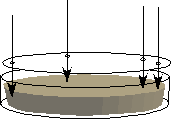ProcedurePrepare serial 10-fold dilutions of transformed bacteria in LB and spread 100 µL onto LB/Amp plates as described in the Electroporation protocol. Incubate at 37°C overnight. Also streak out p ...
Desalt DNA template by EtOH precipitation in NaOAc followed by at least 2x washes with 70% EtOH. Resuspend in 5 - 15 µL of sterile H2O. Rinse cuvettes (if they have been used before) 5x with deionied ...
1. Grow 250 500 mL of bacteria overnight in LB with 50 µg/mL of ampicillin.2. Transfer culture to Nalgene bottles. Spin in SGA rotor at 6000 rpm at 4°C for 10 min.3. Discard supernatant. Keep everyt ...
Most plasmids can be adequately prepped by kits containing DNA binding columns. These columns do not do a great job of separating plasmid DNA from contaminating bacterial chromosomal DNA. If the chrom ...
The following protocol can be used to optimize ligation conditions for difficult to clone (e.g. very large) fragments. The principle is to independently characterize the ligation kinetics of the vecto ...
Antibiotic ConcentrationsThe following list shows recommended antibiotic concentrations for LB media or agar plates. Antibiotic ConcentrationAmpicillin 100 μg/mLBleocin 5 μg/mLCarbenicillin 100 μg/mLC ...
MaterialsSolution II: 0.2N NaOH/1% SDSSolution III: 3 M KOAc pH4.8RNAseA (DNAse free) 10 µg/mLChloroform/Isoamyl alcohol (1/25 v/v)Isopropanol70 % ethanol13% PEG8000Procedure1) Culture 5 mL of bacteri ...
Materials Colonies of bacteria from Exercise 12.2ToothpicksCrystal violetGram''s iodine95 ethanolSafraninMicroscopes with oil immersion Procedure Before staining the individual colonies you should fir ...
Gram-staining is a four part procedure which uses certain dyes to make a bacterial cell stand out against against its background. The specimen should be mounted and fixed on a slide before you procede ...
1. In microfuge tubes spin down 0.1 ml of uninduced cells grown to near saturation or 0.15 ml of IPTG induced cells. Remove YT (or LB) media with a pipetman or drawn out pasteur pipette and freeze cel ...
The preparation of a smear is required for many laboratory procedures including the Gram-stain. The purpose of making a smear is to fix the bacteria onto the slide and to prevent the sample from being ...
Flagella and motility monotrichous flagella - the bacterial cell has a single flagella peritrichous flagella - the bacterial cell has several flagella which are located at various sites on the cell su ...
Plasmid (pUC series) containing genomic DNA fragments are maintained in E. coli strain DH5aTM. The E. coli cultures are routinely cultured at 37 C on Luria-Bertani (LB) agar on or in LB broth containi ...
1. Place 2 mL of the appropriate sterile medium in a 13 mm yellow-capped culture tube. If more culture is needed place up to 5 mL in a 16 mm green-capped culture tube. Large amount of culture should b ...
Purpose: Bacterial strains may be stored indefinitely at low temperatures (- 20 degrees C and -80 degrees C) in 15 to 40 glycerol. It is lab policy to prepare a frozen stock of newly acquired or creat ...
Inoculate 200 ml L-broth supplemented with appropriate antibiotics with the bacteria to be lyophilized. Incubate the culture at 37°C with vigorous shaking (200-250 rpm) overnight. Add 2 ml (1/100 volu ...
1. Initial inoculum: - From solid media touch an isolated colonies with a sterile applicator or toothpick. - From liquid media touch the culture with the end of a sterile applicator. - From a frozen c ...
Principle: Bacterial cells are streaked onto a medium to obtain an independent isolate. This is done to reduce the likelihood of working with a culture which has become contaminated and/or has accumul ...
Cloning of PCR products Stocks: LB Agar: Luria Broth after Lennox: per Liter Tryptone 10 g Yeast Extract 5 g Sodium Chloride 5 g Bact. Agar 15 g ...
3 agar (200 ml) Add 6 grams agar to 200 ml deionized water. Autoclave to sterilize. 1.6 agar (200 ml) Add 3.2 grams agar to 200 ml deionized water. Autoclave to sterilize. Alkaline Lysis Solution stoc ...






